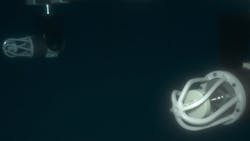Non-contact inspection tool assists with cathodic protection surveys of subsea infrastructure
Editor's note: This Subsea Systems column first appeared in the July/August 2024 issue of Offshore magazine.
By Ariana Hurtado, Editor and Director of Special Reports
Cathodic protection (CP) is used to control the corrosion of metal surfaces of subsea pipelines, infrastructure and equipment. FORCE Technology Norway AS, a technology consultancy and service company, provides corrosion control services such as CP surveys, CP design and modeling, CP for internal corrosion of stainless steel, surface treatments and coatings, and other corrosion prevention services and materials.
"The offshore oil and gas sector depends heavily on cathodic protection due to the challenging environment of the offshore (subsea) structures," Svenn Magne Wigen, sales manager with FORCE Technology, told Offshore. "Subsea pipelines, platforms and other infrastructure are constantly exposed to seawater, which is a highly corrosive environment. Regular CP surveys ensure that the CP systems effectively protect these assets throughout their operational life, thus ensuring safety, preventing leaks, avoiding costly unplanned maintenance or failures."
The company's FiGS technology is a non-contact inspection tool that assists with CP surveying for submerged marine structures and updates the user on the condition of their assets. The technology was designed to provide a more precise and comprehensive assessment of CP systems with a non-contact sensor. Specifically, the sensor was developed to detect tiny coating defects.
"The sensor also provides accurate data on the performance of anodes, which is crucial for effective CP management," Wigen added. "The FiGS technology combines high-resolution field gradient measurements with advanced CP modeling capabilities, enabling precise diagnostics and predictive maintenance strategies."
He also said the company developed the technology to address limitations of conventional CP survey techniques in terms of accuracy.
"Alternatives to FiGS, such as conventional CP probes and fixed field gradient measurements, have limitations in accuracy, especially for assets that are buried or have a complex geometry," Wigen said. "The conventional methods often provide data that requires extensive analyses to provide an interpretation."
In addition, minor coating damages might be overlooked, and results on anode efficiency could be inaccurate. He said these traditional methods also tend to be slower in execution, and they sometimes even require physical contact with the structure.
"Conventional field gradient sensors typically use a twin cell probe with fixed (stationary) reference electrodes," Wigen added. "This probe measures the intensity of the electric field in the direction of the sensor orientation but will not provide information about the direction of the field. With FiGS, the direction as well as the magnitude of the electric field are measured, giving additional valuable information about the source of the signals measured. This facilitates the post-processing of the field gradient data (e.g., the process of filtering out noise in the data). FiGS does not require any form of calibration and can be run continuously from start to end of the pipeline/asset survey. The sensor is highly sensitive, allowing for detection of relatively small coating damages or weakly active anodes (e.g., on buried pipelines/structures)."
The sensor can be attached to both ROVs and AUVs, enabling it to inspect a range of subsea structures in the oil, gas and renewable energy sectors. Offshore assets that can be surveyed include pipelines (exposed or buried), subsea structures (e.g., manifolds and wells), jackets, floating vessels (e.g., FPSOs), and the submerged parts of the foundations for offshore wind turbines (e.g., monopiles). FiGS' first commercial pipeline survey was carried out in 2013.
"Recent developments include the use of resident FiGS on unmanned platforms, implying that CP surveys can be carried out as and when needed, without the topside crew and vessel costs of traditional survey methods," he said. "The offshore vessel time is reduced, thereby reducing the environmental impacts, the risks associated with subsea activities and the cost of operation."
A FiGS report includes the:
- Potential profile for pipelines and/or potential distribution for 3D structures to identify hotspots and areas of under-protection;
- Anode current output (pipeline and structure anodes);
- Effective steel current density (including coating breakdown for coated pipelines/structures);
- Current drain (i.e., current supplied by anodes) on pipeline/structures to adjacent structures, such as wells;
- Life expectancy of a CP system (i.e. remaining life of sacrificial anodes and time to loss of protection); and
- Recommended time to next inspection based on condition of CP system.
"Moreover, the ability of FiGS to provide detailed inspection data rapidly not only allows for quicker and more accurate assessments of CP status, but also ensures compliance with safety standards by providing information regarding the lifespan of CP systems," Wigen said.
Top of Form
Case study
The FiGS technology was utilized for offshore pipelines affected by trawling, which damaged the protective coating and the pipeline anodes. The survey identified sections where the CP systems were still functional and other sections where immediate attention was required, Wigen explained. "This allowed for targeted interventions in terms of CP retrofit that significantly reduced the cost of extending the operational life of the pipelines," he added. "Detailed data from FiGS also helped refine the risk models and inspection schedules, ensuring more reliable asset performance and compliance with safety standards."
New developments
FORCE Technology plans to continue the development of the FiGS technology, aiming to increase its applicability in deeper waters and to other sectors such as offshore wind. Wigens added, "Combining data from all pipelines and subsea structures within an entire field will provide a more complete view of the overall CP status."
The company also plans to integrate digital twin technologies to create more dynamic and user-friendly CP management systems. "Coupled with the latest cloud-based online reporting and visualization tools, FORCE Technology offers a centralized portal for sharing CP information across an entire development or over multiple sites," Wigen concluded. "This integration facilitates significant cost savings by enabling a long-term, data-driven maintenance strategy, grounded in precise lifespan predictions for each CP system, safeguarding the entire subsea infrastructure."
About the Author
Ariana Hurtado
Editor-in-Chief
With more than a decade of copy editing, project management and journalism experience, Ariana Hurtado is a seasoned managing editor born and raised in the energy capital of the world—Houston, Texas. She currently serves as editor-in-chief of Offshore, overseeing the editorial team, its content and the brand's growth from a digital perspective.
Utilizing her editorial expertise, she manages digital media for the Offshore team. She also helps create and oversee new special industry reports and revolutionizes existing supplements, while also contributing content to Offshore's magazine, newsletters and website as a copy editor and writer.
Prior to her current role, she served as Offshore's editor and director of special reports from April 2022 to December 2024. Before joining Offshore, she served as senior managing editor of publications with Hart Energy. Prior to her nearly nine years with Hart, she worked on the copy desk as a news editor at the Houston Chronicle.
She graduated magna cum laude with a bachelor's degree in journalism from the University of Houston.




